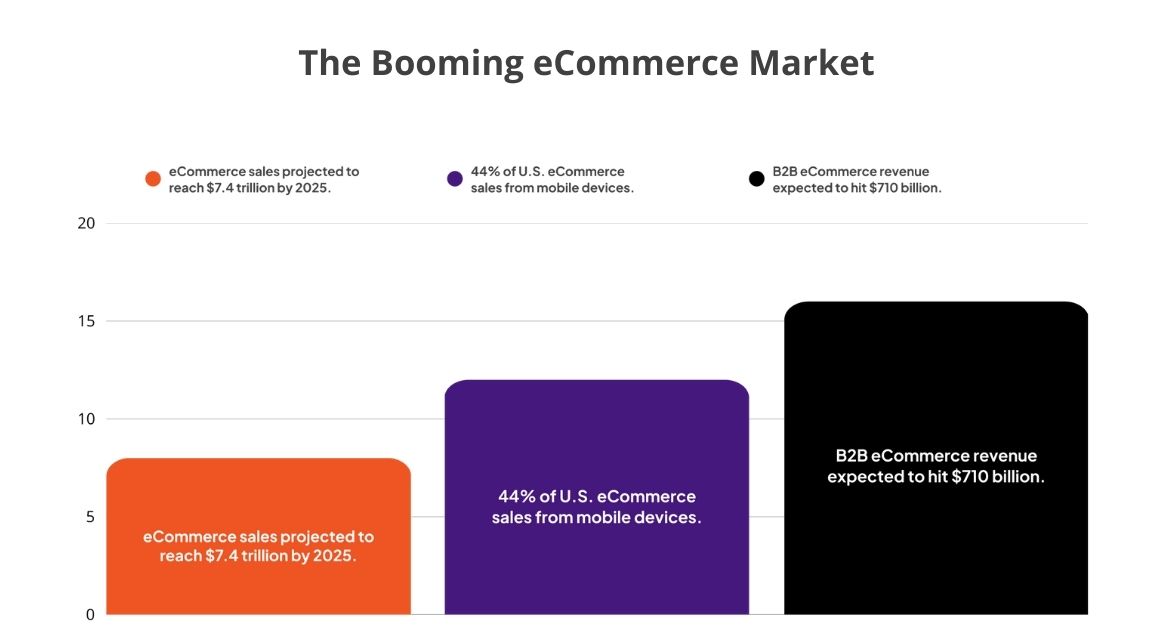The scale of global eCommerce retail sales is projected to hit $7.4 trillion worldwide by the end of 2025, as per the latest report of Exploding Topics and Whop. 44% of U.S. eCommerce sales will come from mobile devices, and B2B eCommerce platform development revenue is expected to reach $710 billion, another report by Hostinger reveals.
For eCommerce platforms, consumer behavior while looking for the products plays a crucial role in the overall growth of the business. Statistics from a reputable report by Webfx show that 95% of the purchases are expected to be seen from eCommerce businesses by the end of 2040.
The eCommerce market is booming. The eCommerce advantage has empowered consumers to shop from online stores as they prefer to buy products of their choice from the comfort of their houses. The wish to shop for products of all categories on one common platform has paved the path for the emergence of diversified eCommerce businesses.
Businesses across industries are trying to penetrate eCommerce businesses and excel in their domain. eCommerce businesses will have a penetration rate of 63.4% and over 4.5 billion users globally by 2028, another statistic revealed by Whop in their annual report.
As there is a rapid emergence of B2B eCommerce solutions, the wants of consumers are also increasing constantly. Therefore, for every company, competition among other B2C commerce businesses is also increasing. Here comes the necessity of incorporating new techniques, which will further lead to improvement in the eCommerce business operations.
Employing a constructive strategy of the application of technology for decision-making is important. This blog emphasizes the top tactics for eCommerce advantage and how it helps in the development of any company.
Understanding Competitive Advantage in eCommerce
A competitive eCommerce advantage in the context of content marketing means possessing some factors that make a business differentiate from the rivals in eCommerce. It can be anything from a company’s product being of better quality than that of the competitors as well as being cheaper or the site being easier to use and providing more friendly customer relations than the competition as well as upcoming technological creativity in the business.
The advantage of eCommerce brands is that they are good for building their brand around such a factor known as the unique selling proposition (USP).

For instance, Amazon is great at its speed and being customer-centric, while Nike and Adidas do an equally great job at exclusivity and creating brand narrative.
- It is important for businesses to not only factor their competence but also the gaps that they can resolve
- After that they can come up with strategies that will offer customers value beyond their expectations.
- The three drives employed in the long-run orientation and management are the use of innovation, operational excellence, and customer relations.
Key Strategies to Gain a Competitive eCommerce Advantage
Leveraging Advanced Technology
Technology is one of the most important factors in carrying out and running an eCommerce business. eCommerce advantages are visible in newer technologies that can be implemented in businesses to increase effectiveness and customer satisfaction:
AI-driven Sales Funnel: A recommendation engine enhanced with AI capabilities on the customer’s past and current behavior to provide better and high-margin sales. While these algorithms help analyze past buys, site visits and interests in products; they give a personal touch to shopping.
Chatbots and AI-Powered Customer Support: Automated responses to customers’ inquiries raise engagement and decrease the amount of time needed for a response. With the help of chatbots, possible scenarios are FAQs, status inquiry of the order, and even a discount code, among others.
Augmented Reality (AR) & Virtual Reality (VR): AR/VR greatly helps customers make a buying decision with convenience and helps in selling apparel and furniture and other commodities. This interactive scenario minimizes the cases of returning goods and enhances customers’ confidence levels.
Blockchain technology: It gives a guarantee and a secure means of bringing about the transaction; this in turn will enhance the trust of the customers, especially when making expensive purchases.
The adoption of such technologies improves the client experience, boosts conversion rates, and increases brand equity.
Optimizing User Experience (UX) and Website Performance
There are many aspects to how much and how efficiently consumers are engaged with the website interface that will dictate eCommerce success.
The following are the features that must be highlighted:
Mobile-Friendly: More than 70% of traffic comes from mobile devices. This means that the website can be accessed from any form of technology depending on the needs of the user, including from any portable device.
Fast-Loading Pages: Web design is one of the main elements when it comes to web design, and it is a famous fact that slow websites switch off the customers. Minimize image sizes and use CDNs and caching settings to improve the speed of the website. It is also evident that, every second that a webpage takes to load, conversion rates decrease by 7 percent.
Streamlined Checkout Process: Some of the measures include simplifying the checkout steps and allowing the guest to checkout and check out through multiple gateways. Features like one-click purchasing and the use of digital wallets in the purchasing process make it easier for the clients.
User-friendly navigation: A well-arranged website layout with smoothly placed categories, filters and a search bar enhance the user experience of the website.
Optimizing the web design means that the flow of shopping is as easy as possible, and thus more people will make the purchase and continue shopping again with that company.
Data-Driven Decision-Making
Every organization that manages to implement the use of data in the right manner stands to benefit from the aspect of making the right decision to increase performance and satisfaction of clients.
Using Analytics Tools: Google Analytics, Shopify Insights, and some other tools assist in understanding customers’ behavior as well as tweaking the marketing strategies. Thus, measures like bounce rate, time spent on the website, and conversion rate are quite helpful and informative.
A/B Testing: eCommerce advantages are counted in A/B testing. It is used to see which plans and designs on the website, product description, and different structure of emails will be more effective. The predictive analytics method powered by artificial intelligence generates demand forecasts via tools that enable businesses to operate their supply chains effectively and avoid inventory shortages while minimizing excess stock.
Predictive Analytics: Effective market segmentation occurs through analyzing customer demographics alongside purchasing behaviors to deliver more focused marketing efforts with better results in maintaining customer relationships.
The application of data insights helps businesses improve their strategic approach and achieve peak profit levels.
Building a Strong Brand Identity and Customer Loyalty
A strong brand fosters customer trust and loyalty. Strategies to achieve this include:
Businesses should combine storytelling approaches with brand consistency methods to create emotional support between brands and their customers through the communication of brand values and mission statements. A compelling narrative differentiates a brand from competitors.
Rewarding customers through loyalty programs that offer them points or discounts or select deals helps build repeat business. Companies that implement membership schemes along with various discount tiers and referral programs achieve higher retention rates from their customers.
Email marketing that provides targeted content to customers creates better engagement and results in higher customer retention rates. eCommerce advantages businesses that sort their email recipient lists by transaction records and personal customer preferences yield higher conversion metrics during their campaigns.
A commitment to delivering outstanding service through uninterrupted support, together with a convenient returns policy and easy refunds, generates both customer contentment and trust in the brand.
A well-developed brand identity helps companies set themselves apart from their competitors in the competitive market.
Multi-Channel Selling and Omnichannel Experience
Broad customer access is achieved when businesses extend their operations across various platforms.
Through marketplaces such as Amazon and eBay, along with Etsy, businesses gain new revenue opportunities, which boost their brand exposure.
Businesses can leverage social interaction combined with spontaneous purchase behaviors by using social media networks such as Instagram, Facebook, and TikTok for direct product sales.
A single shopping experience originates from the seamless synchronization of inventory data and sales across all online and offline channels. The BOPIS feature, together with Buy Online, enhances shelf-life benefits for customers.
A strategy that uses multiple channels helps businesses reach more customers while providing better convenience to their clients.
Implementing Competitive Pricing Strategies
Customers base their purchasing decisions on price significantly. Business organizations must use intelligent pricing methods to maintain their market competitiveness.
Dynamic Pricing: Organizations benefit from dynamic pricing models because they set prices according to market demand and consumer reactions to achieve profitable outcomes.
Value-based pricing: Embedded within the context of this approach is the fact that buyers get persuaded; there are reasons why such products should appeal at the price set for them; this sets the foundation for value-based pricing. Creating special offers or promotions is useful if you want to appeal to these high-ticket clients.
Subscription Plans: In the revenue model, the use of subscription-based products gives a guarantee of a constant flow of cash and customer loyalty in the future. Services like Amazon Prime leverage this model successfully.
Pricing strategies enable one to attract low-end consumers as well as ensure that he or she earns maximum profit margins.
Sustainable and Ethical eCommerce Practices
Today’s consumers are very sensitive to issues of sustainability. It is widely recognized that the introduction of measures to improve the environmental performance of an organization will improve the company’s image.
Sustainability: For earth-conscious consumers, such as the millennial generation, they will go for products that are packaged in ecological packaging material.
Ethical Pursuits: Sourcing and use of labor are two factors that can greatly enhance the credibility of a business entity.
Corporate Social Responsibility (CSR): It is a key factor that determines how participating organizations can assist social and environmental causes to enhance the relations between them and their customers.
Environmental considerations set a company and its products apart and make consumers choose a particular brand.
Case Studies: Brands That Gained a Competitive Edge
Example 1: AI-Driven Personalization
An online fashion retailer introduced an intelligent fashion model to select clothing for customers; as a result, the company saw its average order value increase by 30 percent.
Example 2: Sustainability as a Differentiator
A footwear brand recently started using their products and recyclable material in packing, which leads to increased sales and attracts customers who care for the environment.
Example 3: Omnichannel Success
A beauty brand provided its customers with a consistent shopping experience regardless of whether they were initially bought online; thanks to that, the revenue has grown by 40% since we collaborated with them.
Concluding Thoughts
Achieving competitiveness in eCommerce is not an easy task and has to be addressed at different levels. Companies are trying to stand out in the overcrowded market and enhance quality and experience, leveraging technology, providing user experience, data-driven decisions, and brand building.
Several factors make the company more competitive, including the integration of sustainability into a firm’s management and operations and the use of omnichannel ecommerce selling.
FAQs
Q1. What are the most effective ways to differentiate an eCommerce business from competitors?
To stand out in the crowded eCommerce market, businesses should focus on:
- Personalized Customer Experience: Use AI-driven recommendations and targeted marketing to engage users.
- Superior Customer Service: We offer 24/7 support, hassle-free returns, and fast delivery options.
Q2. How can data analytics help in gaining a competitive advantage in eCommerce?
Data analytics enables businesses to make informed decisions by analyzing customer behavior, trends, and sales performance. Key benefits include:
- Customer Insights: Helps in segmenting customers based on their preferences, allowing for personalized marketing.
- Inventory Optimization: Predictive analytics can forecast demand, reducing stockouts and overstocking issues.
Q3. How important are website speed and user experience (UX) in eCommerce success?
Website speed and UX are critical factors that directly impact conversions and customer satisfaction. Key reasons include:
- Faster Load Times Improve Conversions: A delay of just 1 second in page loading can reduce conversions by 7%.
- Seamless Navigation Enhances User Engagement: A well-structured website with an intuitive design encourages users to browse more.























